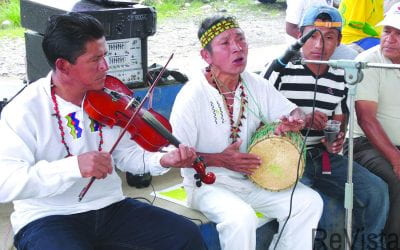K-dramas Flow into Latin America
A Look at Korea’s Cultural Products
I was at Chile’s Santiago airport some months ago when I heard a group of young ladies chanting and cheering. I couldn’t really understand what they were saying, while running with short steps from one place to another. Their chanting continued in what sounded like Japanese or Korean, until I recognized some words: Super Junior. The k-pop group was leaving Chile after a successful and massive concert, and their fans were following them until their last moments in the country. The next day there was barely a note about it in an interior page of a Chilean newspaper, and only some seconds’ mention on a TV news program. How come a musical group with so many and loyal fans had no publicity in the media? Welcome to the hallyu experience.
Korean pop groups and television dramas broke frontiers and arrived on Latin American soil more than 15 years ago. Their popularity has increased thanks to the easy access to these products through the Internet, and to thousands of fans around the world who upload, classify, and share these songs and episodes to the delight of the South Korean government.
The Asian products have been part of the Latin American culture for decades. TV cartoons from Japan—animes—are part of the regular schedule since the mid 60’s when Astroboy was first broadcasted, followed by Street Racer (Meteoro, in Latin America), Knights of the Zodiac, Dragon Ball, Mazinger Z, Rurouni Kenshin, only to name a few that followed in the next decades. Martial arts films and video games from Asia also flooded the world, as did the comic books, known as manga. These products were mainly targeted at the male audience, but a few products—such as Candy Candy, Sakura Card-captors and some manga shojo—were aimed at the female audience. But at the turn of the century, that changed.
Japan has been a huge production center of animes, TV shows, mangas, pop music and such. But by the end of the 20th century other production centers started to expand. South Korea was one of them, and cultural industries played a role as well as politics. After the country restated its political relationship with China, Korean TV dramas and pop music groups started to appear on China’s television and music venues. Up until then, Japanese doramas—TV fiction shows, called that after the English word drama—ruled the Asian market, as did the J-pop, Japanese boy band or girl groups that sang and danced catchy themes mainly attracting young audiences. South Korea’s entertainment industry also worked on training aidorus—after the English word idols—young men and women who became models, singers or actors/actresses. At the same time, new television stations changed the format of their dramas, shortening them and creating original soundtracks (OST) for the shows, which were usually performed by pop singers, creating a synergy between music and television industries, and later fashion and make-up industries. The Korean government supported them as a way to promote an image of a modern and dynamic Korea.
To differentiate their national products from Japanese ones, Korean songs are known as k-pop, and their TV series as k-dramas. A performance in Beijing of HOT—a k-pop boy band—had a huge success, taking by surprise the Chinese media, which started to talk about the Korean wave: the hallyu was born.
Hallyu means wave or flow, and is used to describe the cultural phenomenon that includes music, television dramas and films from South Korea. These products didn’t only succeed in China but also in Japan, Taiwan, Singapore and many other Asian countries. Thanks to the Internet they reached several other regions of the world, with young females as their main audience. Blogs and web pages started to appear offering episodes of k-dramas, and fans started to watch them even without speaking Korean. Some websites started a collaborative work to subtitle the episodes: the fansubs were born. Web pages that allow people to learn Korean were easily found, and in 2013 the applications to take the proficiency test in Korean had quadrupled compared to 2004.
K-dramas arrived to Latin America in the early years of this century, when Mexico started dubbing them. In Peru, the Korean embassy wanted to promote the country’s image in the context of the 2002 Soccer World Cup, and offered k-dramas to the national public broadcast station, TV Peru. Since there was no money to pay for the products, the embassy offered them for free if the station would also broadcast promotional videos of Korea. Since then, k-dramas continued to be shown in the country: until 2010 by TV Peru, then by Panamericana—a private broadcasting company—and since 2016 also by Willax, a small TV station that is trying to increase its share of the Peruvian television market.
One would imagine that these series are a huge success with the audience, but it isn’t so. They barely reach two points on the ratings, which is pretty low for what is expected on Peruvian television. So how have they survived more than 15 years on Peruvian television screens? On the one hand, k-dramas have young female die-hard fans who are willing to watch the series over and over, despite having watched it before in Korean, subtitled, or even on other TV stations. On the other hand, the broadcasting companies that have aired the k-dramas have low ratings, with these programs often being their most watched shows. The low cost of buying a k-drama compared to the audience the station gains seems to make it a profitable business. The problem of depending on these k-dramas is that it will not allow those stations to grow but just to survive, and there is always the risk that the audiences will start to fade away. But for now, we still see in Peru and other Latin countries young people dancing to the music of k-pop, buying magazines with news and pictures of their aidorus, or running around the airport to have a last glance when their Korean stars leave the country.
Fall 2018, Volume XVIII, Number 1
James A. Dettleff is an Audiovisual Professor at Pontificia Universidad Católica del Perú, and a Ph.D(c) in communications at Universidad Católica de Chile, researching TV series and films as part of the cultural memory of the internal war in Perú.
Related Articles
From Vendedor to Fashion Designer
English + Español
Korean immigrants in Latin America are shaping and developing fashion economies there. Upon arrival, Korean immigrants to Argentina and Brazil may have been lonely, isolated and confused…
Shared Sentiments Inspire New Cultural Centers
English + Español
In the early afternoon of January 3, 2018, in the mountainous village of Shicang, Zhejiang Province, China, firecrackers burst into the air and flags waved in the wind as a parade of Clan…
Evidence for Hope: Making Human Rights Work in the 21st Century
A Review of Evidence for Hope: Making Human Rights Work in the 21st Century Contemporary Human Rights and Latin America On September 5, 1921, Roscoe “Fatty” Arbuckle, Hollywood’s then best-paid star, attended a party in San Francisco’s St. Francis Hotel, drank...







